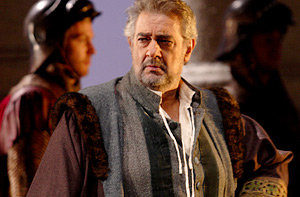
Plácido Domingo plays the title role in LA Opera’s "Simon Boccanegra." / Photo by Catherine Ashmore, courtesy of LA Opera
It is said that history does not repeat itself, but it frequently rhymes. This adage is wonderfully demonstrated as you watch the events in Simon Boccanegra unfold. For composer Giuseppe Verdi, his 1857 opera dramatizing the struggle between the Guelphs and Ghibellines (warring factions in 14th-century Genoa) was undoubtedly also a commentary on the revolutionary events taking place in his own 19th-century Italy. Likewise, for viewers of LA Opera’s new production, it will not be much of a stretch to see the opera, with its underpinning of intractable partisan strife, as a sharply drawn parallel to the current American political scene.
The problem is that the labyrinthine nuances of political processes, with their often-boring debates, are not automatically fascinating to everyone. While political junkies may be easily entertained by scheming statesmen, the challenge was and is to find charm and appeal for a general audience. Verdi recognized the problems with the original plot and hired a second librettist to substantially rewrite the opera in 1881. It is this second version which is usually performed today and which LA Opera has mounted. But even so, trying to get a sense of the revised opera by reading its synopsis is like trying to assemble furniture with a badly translated Chinese manual.
Watching it makes more sense than reading about it, but still, some opera-goers may find the production laborious. Two women seated next to me who had never seen an opera before proclaimed it “very slow” at intermission. But I suspect more experienced opera buffs will find plenty to enjoy here. First, the sets are well thought out and make good use of formal Renaissance perspective. A colonnade of foreshortened columns recedes at stage left and perspective lines along the floor converge at a vanishing point, perhaps a clever reminder that it was the Genovese polymath Leon Battista Alberti who published the first scientific study of perspective in 1435. For me, at least, the obvious vanishing point ultimately became a resonant metaphor of the fate that awaited the opera’s namesake at the end.
The lighting is also a high point. Low mounted spotlights in the wings caused exaggerated shadows to appear at times, contributing to the dramatic mood. In Scene II, the council chamber, and Scene III, the map room in the Doge’s palace, the subtle indirect lighting produced a warm glow that made it seem as if you were looking into a 3D Vermeer painting. The lighting also helped draw attention to the clever use of words to convey the changing political climate. In the early scenes in the council chamber, the rear wall was painted with phrases of imperial power, written in Latin. Later on, after the Guelph uprising, the wall was spotlit to reveal a jumble of graffiti, all in Italian.
The cast is solid, both in singing and acting ability. LA Opera maestro Plácido Domingo is in the title role, and there is no sign of weakness or aging in his famous tenor. Ana Maria Martinez as Boccanegra’s daughter, Amelia, is also a delight to hear — tender and plaintive, yet powerful in full throat when needed. Stefano Secco, as Adorno, her lover, makes his LA Opera debut and effectively wrings the maximum amount of emotional content from his role.
If you are looking for the melodic Verdi with shades of bel canto here, you will be disappointed. The music, while beautiful and with little discordance, is devoid of memorable tunes. Both textually and musically, the tone of the opera is relentlessly somber. In Act III, the lover Adorno proclaims, “All happiness is but an illusion. The heart is an endless source of grief.” The score effectively echoes this sentiment with portentous flourishes and minor key shifts, guiding us along the inexorable path toward the tragic end. At times, we are also reminded that by the time Verdi wrote Simon Boccanegra, Richard Wagner had already become a sensation throughout the opera world, and it is not difficult to recognize some tentative musical nods Verdi makes in acknowledgement of Wagner’s powerful influence.
For opera novices, all the positives of this opera may not be enough to overcome the downbeat mood, stately pace and opacity of the plot. But for opera lovers, Simon Boccanegra is a no-brainer. The music is masterful, the costuming is splendid, and the sets, lighting and stage direction all reveal a thoughtfulness that rewards the attentive with deeper insights. Finally, the story optimistically reminds us that the struggles that ensue between opposed parties in times of turmoil and transition need not be a sign of cultural decline or perpetual discord, but are simply a necessary precursor to a better future.
—David Maurer, Culture Spot LA
Simon Boccanegra runs through March 4 at the Dorothy Chandler Pavilion. Visit www.laopera.com.





